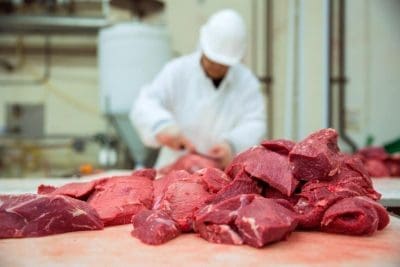A RECENTLY released research report showed the strong performance of the Australian red meat processing industry during the COVID pandemic since early 2020, with the industry demonstrating its ability to maintain reliable supplies to both domestic and international customers under challenging circumstances.
Commissioned by the Australian Meat Processor Corporation, the study conducted by BIS Oxford Economics looked at the period from 1 April to 30 September 2020.
 The report suggested that the industry not only dealt with the pandemic within processing plants themselves, but it also dealt with logistical and labour supply shocks.
The report suggested that the industry not only dealt with the pandemic within processing plants themselves, but it also dealt with logistical and labour supply shocks.
The skill and flexibility of the meat processing industry was a contributing factor for the pandemic creating only modest impacts on industry revenues, the report found.
Titled Impact of COVID-19 on the red meat processing industry, the report made a number of findings that indicate a strong and resilient sector. It found that while the broader industry took an estimated three percent hit to national revenue during the most severe period of COVID impact (April to September 2020), Australian processors performed and responded well.
On the ground, they demonstrated skill and flexibility in managing logistical and workforce disruptions to maintain supplies to domestic and international markets, the authors found.
AMPC chief executive Chris Taylor said Australia’s red meat processors coped relatively well with the pandemic during 2020.
“Australia’s reputation was enhanced as it emerged as a reliable supplier relative to its
competitors. The pandemic has reinforced Australia’s resilience enabling it to demonstrate the country’s strengths in terms of reliability and quality of product,” he said.
Australia’s export performance during the pandemic was affected by the impacts of herd rebuilding after drought. However Australia’s key international competitors such the United States and Argentina suffered considerably more disruption to their exports than Australia. New Zealand also performed well while Brazil appeared to have made a remarkable recovery to expand exports.
The report recommended that Australia’s strong performance is something that should be capitalised on in the post-pandemic years.
Challenges remain in labour and supply
Domestically, the issue of future workforce and supply remains an important issue for processors.
Recently Australia had seen the reopening of borders which may have eased these pressures. However, it was unlikely that the industry’s workforce structure will return to its pre-pandemic levels.
Over the long-term, the report outlined future strategies including:
Pandemic and general disaster preparedness
The Australian red meat industry coped well when confronted by the pandemic. This was due to the skill, dedication, and flexibility of many in the industry and allied industries such as transport and logistics and retailers. The pandemic acted as an unforeseen industry “stress test”.
The report recommended that Federal and State governments and industry work together on future disaster preparedness.
Export diversification
Australia’s international competitors’ challenges highlighted the potential for Australia to focus on more actively promoting its strengths in the global market. The growth opportunity lies in diversifying export opportunities to capitalise on the reputation Australia has developed as a safe and reliable supplier of quality red meat products.
In 2019, China accounted for 28.5pc of Australia’s red meat exports. Since then, both COVID and trade tensions have impacted that market.
The processing sector recognised the potential for capitalising on its performance during the pandemic to explore opportunities for expansion into markets in India and Southeast Asia. It may also be possible to take advantage of recent changes to demand in the post-Brexit UK and the EU.
AMPC is commissioning an updated report on the impact of COVID on the processing sector in 2021 due for release in 2022.
Source: AMPC
